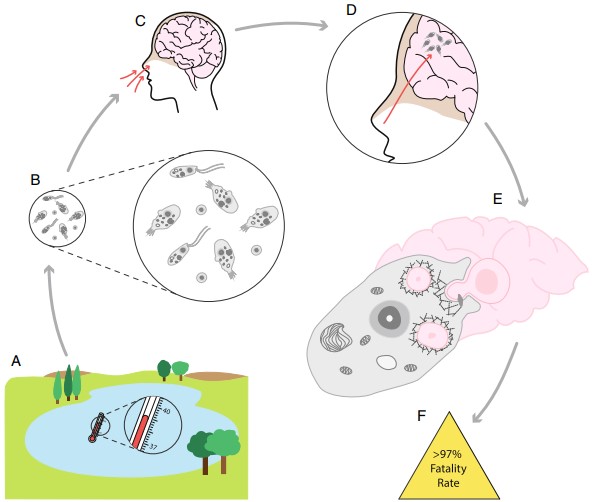Naegleria fowleri-derived Exosome Research and Application
Naegleria fowleri, commonly known as the "brain-eating amoeba," invades the human body through the nasal cavity, causing primary amoebic meningoencephalitis (PAM), a disease with a high mortality rate. Recent studies have shown that this amoeba can release exosomes, which act as tools for intercellular communication and play a crucial role in the interaction between host and parasite and in the pathogenesis of diseases. Creative Biolabs believes that research on Naegleria fowleri-derived exosomes is of great significance for understanding the pathophysiological process of PAM, discovering new therapeutic targets, and developing rapid and accurate diagnostic tools.
 Fig.1 Infection of humans by Naegleria fowleri.1,2
Fig.1 Infection of humans by Naegleria fowleri.1,2
Survival Adaptability and Fatal Infection Pathways of Naegleria fowleri
-
Lifestyle of Naegleria fowleri: Naegleria fowleri is a single-celled protozoan that lives freely in warm freshwater environments. It can survive in temperatures up to 46°C and feeds on bacteria. Naegleria fowleri has three life forms: trophozoites, flagellates, and cysts, and can change its form according to external environmental conditions.
-
Infection Pathway of Naegleria fowleri: When in contact with contaminated water through the nasal cavity, the trophozoites can invade the human body, travel along the olfactory nerve into the brain, and cause primary amoebic PAM, a rare but extremely fatal disease characterized by inflammation and brain tissue damage, with a mortality rate of up to 95%.
-
Symptoms of PAM: Rapid and severe, the average time from onset to death is about five days. Early symptoms are similar to influenza, which then rapidly evolve into severe central nervous system damage. Due to the lack of effective treatment and the severe side effects of drugs, the survival rate remains very low.
-
Innovation in PAM Treatment Research: In the latest advancements in PAM treatment research, scientists have started to focus on the exosomes released by Naegleria fowleri. These tiny structures play a crucial role in the interaction between host and amoeba and the development of the disease and may become key in developing new therapies and rapid diagnostic tools.
Discovered Functions of Naegleria fowleri-derived Exosomes
-
Activation of the Host Immune System and Inflammation Promotion: Studies have shown that Naegleria fowleri-derived exosomes can be internalized by host immune cells, thereby stimulating the host cell's immune response. These exosomes also activate host cells and promote immune responses by upregulating the expression of co-stimulatory molecules and pro-inflammatory cytokines.1,2
-
Promotion of Disease Progression: The internalization of these exosomes and their carried immune-stimulating molecules may promote the pathophysiological process of PAM. By activating the host's immune response, they lead to brain inflammation and damage, which are among the primary causes of PAM's high mortality rate. Research also found that although these exosomes stimulate an immune response, they do not directly affect macrophage apoptosis, suggesting they may play a role in the pathological process through non-cell death pathways.
Potential Applications of Naegleria fowleri-derived Exosomes
-
Diagnostic and Therapeutic Potential: Through proteomic analysis, researchers have identified over 2000 proteins in Naegleria fowleri-derived exosomes. Further exploration of key molecules in these exosomes can help understand the pathogen's invasion strategies and the host's defense mechanisms, and develop new targets for diagnosing or treating PAM.3
-
Environmental Monitoring Potential: As global temperature rise may expand the habitat of Naegleria fowleri, monitoring the presence of its exosomes or key molecules in them may help predict and control the spread of this deadly pathogen.
Creative Biolabs is focused on unlocking the potential value of microorganism-derived exosomes. We have meticulously developed an advanced research platform for microorganism-derived exosomes. If you are keen to explore and harness the potential of microbe-derived exosomes, please do not hesitate to contact us.
Microorganism-derived Exosome Isolation and Identification
In Vitro Functional Discovery of Microorganism-derived Exosomes
In Vivo Functional Discovery of Microorganism-derived Exosomes
References
-
Herman, EK.; et al. Genomics and transcriptomics yields a system-level view of the biology of the pathogen Naegleria fowleri. BMC Biology. 2021, 19(1):142.
-
under Open Access license CC BY 4.0, without modification.
For Research Use Only. Cannot be used by patients.
Related Services:

 Fig.1 Infection of humans by Naegleria fowleri.1,2
Fig.1 Infection of humans by Naegleria fowleri.1,2








